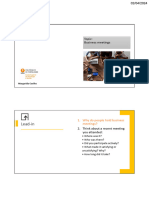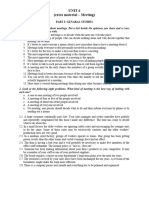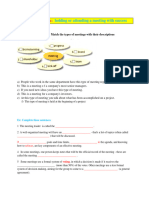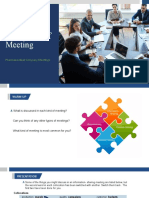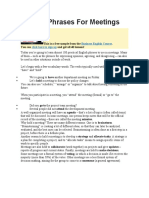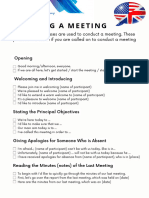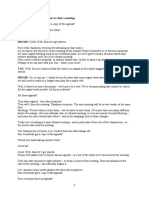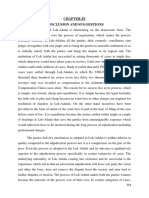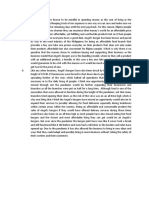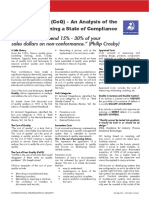Aia Session 1
Uploaded by
ahmedmanqouch5Aia Session 1
Uploaded by
ahmedmanqouch5Unit 1
Work Meetings
Prof. Mariame Naguim
Why Is It Important to Learn About Work Meetings?
Why Is It Important to Learn About Work Meetings?
Teamwork Professional
Better
and Skills and
Decisions
Productivity Leadership
Networking Problem-
Cultural
and Career Solving and
Awareness
Growth Creativity
Word combinations with ‘meeting’
arrange / set up / organize a meeting
fix
bring forward make a meeting earlier than originally
decided
put back / a meeting make a meeting later than originally
postpone planned
cancel not have a meeting after all
run / chair be in charge of a meeting
attend go to a meeting
miss not go to a meeting
Examples:
• Let’s arrange a meeting to discuss next month’s goals.
• The manager wants to bring forward the meeting to Monday instead of
Wednesday.
• We’ll postpone the meeting until next week because the report isn’t ready.
• We have to cancel the meeting because everyone is busy.
• Ms. Smith will run the meeting today.
• All team members must attend the meeting on Friday.
• Try not to miss the meeting, as we’ll be covering important topics.
Types of meeting
Meetings come in all shapes and sizes, of course. Here are some types:
• Chat (informal discussion) with colleagues at the coffee machine.
• Brainstorming among colleagues: where as many ideas as possible are
produced quickly, to be evaluated later.
• Project meeting / team meeting of employees involved in a particular activity.
• Meeting with a customer, for example to discuss a contract.
• Board meeting: an official, formal meeting of a company’s directors.
• Annual general meeting / AGM (BrE); annual meeting (AmE): where
shareholders discuss the company’s annual report.
• EGM: extraordinary general meeting: a shareholders’ meeting to
discuss an important issue such as a proposed merger.
• Department/departmental meeting.
• Meeting with suppliers, for example to negotiate prices for an order.
Reading: How was the meeting?
Some colleagues are discussing a meeting they have just come out of.
Anil: I thought it was very productive.
Juliet: Well, I thought it was a complete waste of time. I didn’t hear anything I
didn’t already know.
Barbara: I agree with Anil. I felt we had some very useful discussions, and that we
reached an agreement that was good for both sides. We certainly covered a lot of
ground. It was incredible the number of things we got through.
Juliet: But there were too many digressions. John was rambling and kept
wandering off the point. He just uses meetings as a chance to show off. He just
wanted to show how powerful he is and what a good talker he is.
Anil: But to be fair, the chair really kept things moving: she encouraged people to
be brief and to stick to the point and we achieved a lot in a short time. Anyway, I
learned a lot and I think they listened to what we had to say.
Exercice 1: Replace the underlined expressions with appropriate forms of the
verbs. In some cases, more than one verb is possible.
chair - put back/postpone – bring forward –– miss – attend -
arrange/fix/set up
A meeting of the Tennis Club Committee was (1) organized for 1 March, but not
everyone could (2) go to it, so it was (3) delayed until March 31. One committee
member said that this was too late, so eventually we (4) moved it to March 15.
The chairperson (5) was in charge of it very efficiently, and we decided on some
new membership rules. Only one committee member (6) did not go to the
meeting.
The role of the chairperson:
A: Before the meeting
Hilary Rhodes is a management consultant who specializes in meeting
skills:
‘A good chairperson has to be a good organizer. What they do before
the meeting is as important as the meeting itself. They should make
sure the agenda (the list of things to be discussed) is complete by
asking those involved what should be on it and then circulating
(distributing) it to everyone concerned. They should check the venue,
making sure the room will be free, without interruptions, until the end
of the meeting.’
B: During the meeting
The chairperson should be a good timekeeper. They should
start the meeting on time, without waiting for latecomers.
They should appoint a minute-taker to take the minutes,
making sure that opinions and action points (where
participants agree to do something) are noted.
They should make sure each point on the agenda is allocated
the time it deserves and should keep to the timetable. When
the time allocated to one point is up, the chair should make
sure that discussion moves on to the next point, even if the
issue has not been completely covered or resolved (decided).
The chair should make sure that each participant has the chance to
make their point, and should deal tactfully with disagreements,
making sure that each side feels their point of view has been noted.
They should also try to avoid digressions, where people get off the
point.
Finally, they should ensure the meeting finishes on time, or early.
C: Follow-up
After some meetings, it’s necessary for the minutes to be circulated,
especially if there are action points that particular people are responsible
for.
At the next meeting, the chair should ask for the minutes to be read out
and see if all agree that it is an accurate record of what happened, and
see if there are any matters arising (any points from the last meeting that
need to be discussed). And they should check what progress has been
made on the action points from the previous meeting.
Exercice: Match the verbs (1-7) with the nouns (a-g) that they go with.
1 take a minute-taker
2 appoint b the minutes
3 circulate c time
4 allocate d the agenda
5 move on e to the next point
6 avoid f on time
7 finish g digressions
Exercice: Match the verbs (1-7) with the nouns (a-g) that they go with.
1 take the minutes (b)
2 appoint a minute-taker (a)
3 circulate the agenda (d)
4 allocate time (c)
5 move on to the next point (e)
6 avoid digressions (g)
7 finish on time (f)
Opening a meeting:
Carla Eagleton, chief executive of Creative Advertising, is opening a meeting:
“OK, let's get started.”
She could also have said:
“It's about time we got started.”
“Let’s begin, shall we?”
“Let’s get down to business.”
“Shall we make a start?”
Then she says
“As you know, I’ve called this meeting to discuss the situation in the design
department. The designers have a lot of freedom to work as they wish, but
it seems that things are getting out of control ...”
She could also have said:
“I’ve arranged this meeting to ...”
“As you are aware ... The purpose of this meeting is to ...”
“The main objective is to...”
Inviting people to speak:
Carla then uses some of these expressions.
Inviting someone to start:
“Would you like to open the discussion, Greta?”
“Greta, would you like to kick off?”
“Perhaps you'd like to get the ball rolling, Greta.”
Asking for one person’s opinion:
“What about you, Keith?”
“What do you think about this, Keith?”
“What are your feelings on this, Keith?”
“What are your views on this, Keith?”
Asking for everyone’s opinion:
“What’s the general feeling on this?”
Making your point:
The other participants use some of these expressions.
a) Head of human resources: “I believe the design department needs a certain
amount of freedom, but there are limits.”
b) Head of design: “As I see it, I can’t run the design department as if it was the
accounts department.”
c) Chief financial officer: “In my opinion, they’re going much too far. I can’t bear
to think of the costs involved.”
d) Senior designer: “Of course, we are sensitive types and need to be given the
freedom to work how we like.”
Other ways of making your point include:
- “The way I see it ...”
- “Personally, I think ...”
- “Obviously ...”
- “It’s clear to me that ...”
- “It looks to me as if...”
Note: You use “Of course” and “Obviously” to introduce an idea, but also to
show that you think other people will be aware of it already. Be careful, as this
can sound rude.
Exercice: Match the sentence beginnings (1-5) with the correct endings (a—e)
1) The way a) I think that the prizes we win help us to attract and keep the
best designers.
2) Personally b) as if the design people think of themselves as living on
another planet.
3) It looks to me c) I see it, you should be looking at what we produce, not at the
time of day we produce it.
4) It’s clear to d) opinion, we have to think of the needs of each department.
5) In my e) me that they set a very bad example to the other
departments.
Exercice: Match the sentence beginnings (1-5) with the correct endings (a—e)
1) The way c) I see it, you should be looking at what we produce, not at
the time of day we produce it.
2) Personally a) I think that the prizes we win help us to attract and keep
the best designers.
3) It looks to me b) as if the design people think of themselves as living on
another planet.
4) It’s clear to e) me that they set a very bad example to the other
departments.
5) In my d) opinion, we have to think of the needs of each
department.
Agreement and disagreement
Hilary Rhodes is talking about the importance of keeping calm in meetings:
‘In a meeting, you discuss things. In the discussion, some people may agree with
you. Others may disagree. They may have differences of opinion with you, but
the important thing is to keep calm and remain courteous. It’s OK to disagree,
but it’s not OK to be impolite or rude or to lose your temper.
An argument is when people disagree about something, perhaps becoming
angry. Your argument is also the set of ideas that you use to prove your point: to
show that what you are saying is true.’
Note: Agree and disagree are verbs (e.g. | agree with you, She disagrees with
him, etc.).
You cannot say: I am agree with you, She is disagree with him, etc.
Agreeing
Strong agreement:
a) “You’re perfectly right. The costs involved must be
incredible.”
b) “I couldn’t agree more. We got our latest recruits after
we won the industry award for best advertisement.”
c) “Precisely. Creativity comes to some of our people in
the middle of the night.”
d) “Exactly. We have to look at the company as one unit.”
e) “Absolutely. It’s the output, not the input, that
counts.”
Mild agreement:
f) “You may be right there. We’re already ten per
cent over budget.”
g) “That’s true, I suppose. There must be some
limits on when they work.”
h) “I suppose so. They seem to arrive and then go
straight out again to eat.”
Disagreeing
Mild disagreement:
a) “That’s not really how I see it. Everyone should be allowed to work in
the way that’s best for them.”
b) “I don’t really agree. The prizes are important, but people would come
to work for us anyway.”
c) “I can’t really go along with you there. I think we need to see people at
their desks actually working.”
d) “I think you’re mistaken. If the designers get to work late, they don’t go
out for lunch.”
e) “I’m afraid I can’t agree with you there. All you financial people do is
worry about costs.”
Strong disagreement:
f) “I’m sorry, but that’s out of the question. You can’t expect people to go
home at ten and come back at nine in the morning.”
g) “I think you’re wrong. The design department’s costs are justified
because of our high quality work. The costs of the other departments are
not justified.”
h) “Of course not. The latest figures I’ve seen show that the project is
within budget.”
i) “That’s absurd. There must be some sort of control on when people
work.”
j) “That’s ridiculous. Each department has very specific needs.”
Note: Be careful with ‘That's absurd’ and ‘That's ridiculous’. These
expressions are very strong and can be offensive.
Discussion techniques
Hedging
Hedging is when you avoid disagreeing directly. To hedge, you could say:
“I take your point about punctuality, but clocking in and out would not be very
popular.”
“I understand what you’re saying about the needs of each department, but
each department must be treated in an appropriate way.”
“I see/know what you mean, but we must look at the human factors as well as
the numbers.”
“I hear where you’re coming from on this, but we must remember this is an
advertising agency, not a car factory.”
Checking understanding, interrupting, referring back
To interrupt someone politely:
“Can I come in here?...”
“Sorry to interrupt you, but ...”
“If I can just stop you for a moment ...”
To refer back to what was said earlier:
“As we were saying earlier ...”
“To go back to what I was just saying ...”
“To go back to what X was saying earlier ...”
To check that you understand what someone has said:
“Are you saying that ...?”
“If I understand (you) correctly, ...”
“Are you suggesting that ...?”
“If I follow you...”
“Are you implying that ...?”
Agreement, consensus or compromise?
Hilary Rhodes is talking about how to deal with agreements and
disagreements:
‘It may be possible to reach agreement or to reach an agreement
about something, or at least come to a consensus: something
that most people can agree with. It may be possible to
compromise or to find a compromise: an agreement where
people accept less than they wanted at first. Or perhaps the
differences are so great that there will just be disagreement.
Something in particular that you disagree about is a
disagreement.’
Concluding the meeting
Carla Eagleton sums up and brings the meeting to a close:
‘Right. I’m afraid we’re running out of time so we’re going to have to
stop there. To go over what’s been said, there is a disagreement about
timekeeping and budgets in the design department. I’ve listened to
both sides of the argument. I think I can sum it up by saying that it’s a
problem of creativity versus control. I think you’ll just have to agree to
disagree. I’ll let you know my decision about the solution to this
problem by the end of the month. So unless anyone has anything else
to add, I think that’s it. Thank you all for coming.’
You might also like
- Level 2 Business Communication Booklet-1No ratings yetLevel 2 Business Communication Booklet-171 pages
- Business English Vocabulary Meetings Strong Int PDFNo ratings yetBusiness English Vocabulary Meetings Strong Int PDF11 pages
- Business English Vocabulary Meetings Strong Int100% (6)Business English Vocabulary Meetings Strong Int11 pages
- Useful Business English Meetings PhrasesNo ratings yetUseful Business English Meetings Phrases11 pages
- Useful Business English Phrases For MeetingsNo ratings yetUseful Business English Phrases For Meetings15 pages
- Useful Business English Phrases For Meetings100% (2)Useful Business English Phrases For Meetings15 pages
- Meetings - Small Talk & Starting A Meeting100% (1)Meetings - Small Talk & Starting A Meeting14 pages
- Tourism_mgt_25DEC-2024_Participating in and running professional meetingsNo ratings yetTourism_mgt_25DEC-2024_Participating in and running professional meetings4 pages
- Reader 7524 Business Meetings C-clusterNo ratings yetReader 7524 Business Meetings C-cluster60 pages
- Meetings 1 - Getting Down To Business - WorksheetsNo ratings yetMeetings 1 - Getting Down To Business - Worksheets5 pages
- Meetings (Theory) : The Past Simple Use ExamplesNo ratings yetMeetings (Theory) : The Past Simple Use Examples7 pages
- Modul 4 Unit 6 Meeting 12 & 13 Meetings Business SkillNo ratings yetModul 4 Unit 6 Meeting 12 & 13 Meetings Business Skill21 pages
- Business English: Introduction To Meetings: I - IntroductionsNo ratings yetBusiness English: Introduction To Meetings: I - Introductions7 pages
- History of Edom and Khazaria by Lewis, Melchizedek Y. (1989) Paperback - Lewis, Melchizedek Y. - 9780966542608 - Amazon - Com - Books100% (1)History of Edom and Khazaria by Lewis, Melchizedek Y. (1989) Paperback - Lewis, Melchizedek Y. - 9780966542608 - Amazon - Com - Books1 page
- Understand Your Self Assessment Tax Bill - GOV - UKNo ratings yetUnderstand Your Self Assessment Tax Bill - GOV - UK3 pages
- From An Islamic Perspective Health Is Viewed As One of The Greatest Blessings That God Has Bestowed On MankindNo ratings yetFrom An Islamic Perspective Health Is Viewed As One of The Greatest Blessings That God Has Bestowed On Mankind15 pages
- Oracle 19c - Complete Checklist For Manual Upgrade For Upgrading Oracle 12.x, 18c Container - 2549866.1No ratings yetOracle 19c - Complete Checklist For Manual Upgrade For Upgrading Oracle 12.x, 18c Container - 2549866.113 pages
- File - 20210820 - 221357 - Midtern Test 4-7-2021 KNo ratings yetFile - 20210820 - 221357 - Midtern Test 4-7-2021 K3 pages
- Download Complete Different for Boys 1st Edition Patrick Ness Tea Bendix PDF for All Chapters100% (4)Download Complete Different for Boys 1st Edition Patrick Ness Tea Bendix PDF for All Chapters35 pages
- IndiaFirst Life Guaranteed Pension Plan - 1407135No ratings yetIndiaFirst Life Guaranteed Pension Plan - 14071353 pages
- The Creation of States in International Law 2nd Edition James R. Crawford all chapter instant download100% (7)The Creation of States in International Law 2nd Edition James R. Crawford all chapter instant download82 pages
- Data Sarpras Kec. Dukupuntang - DapodikdasmenNo ratings yetData Sarpras Kec. Dukupuntang - Dapodikdasmen14 pages
- Bsa 1-1, Zodiacal Felicity G. - Time Chapter 1No ratings yetBsa 1-1, Zodiacal Felicity G. - Time Chapter 131 pages




